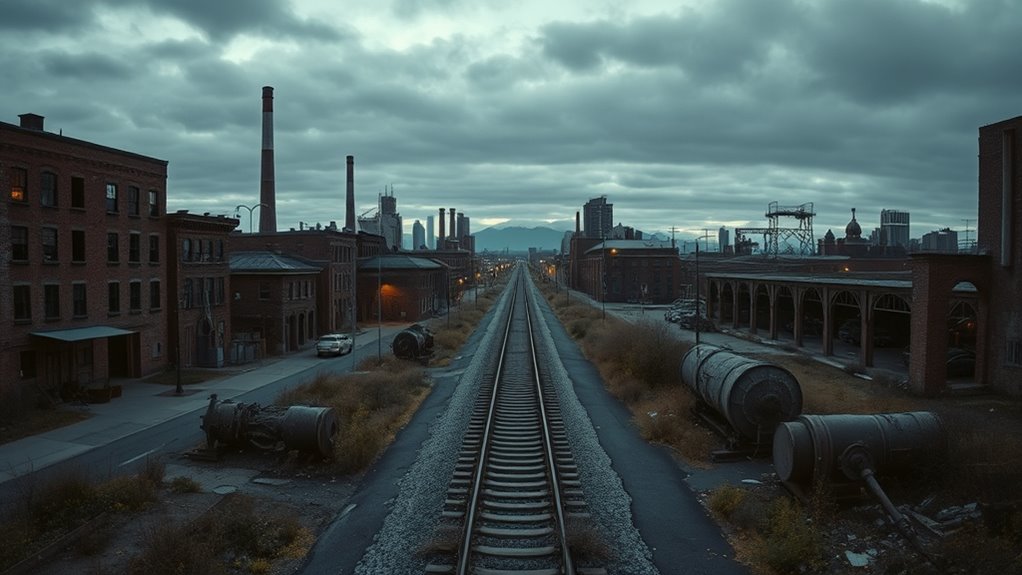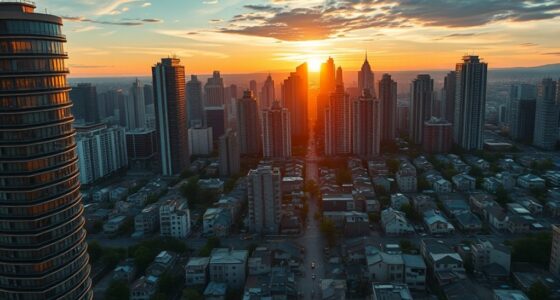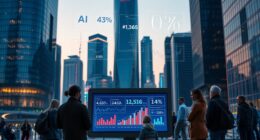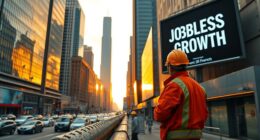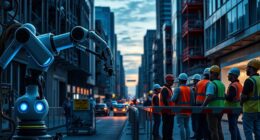As traditional manufacturing declines, your city transforms from an industrial hub into a center for services, finance, and innovation. You’ll see a shift toward knowledge-based industries and urban landscapes designed for creative and technological growth. Opportunities cluster around tech and finance sectors, while neighborhoods often gentrify, deepening socioeconomic divides. Cities form part of a global network, emphasizing connectivity, leisure, and luxury. To explore how these changes reshape urban life, keep exploring these evolving dynamics.
Key Takeaways
- Urban economies shift from manufacturing to knowledge-based sectors like technology and finance.
- Cities focus on innovation, urban renewal, and infrastructure to support new economic activities.
- Socioeconomic divides can deepen due to gentrification and uneven development.
- Globalization fosters interconnected urban centers competing for capital and skilled talent.
- Post-labor cities emphasize leisure, luxury, digital connectivity, and urban vibrancy to attract residents and investment.
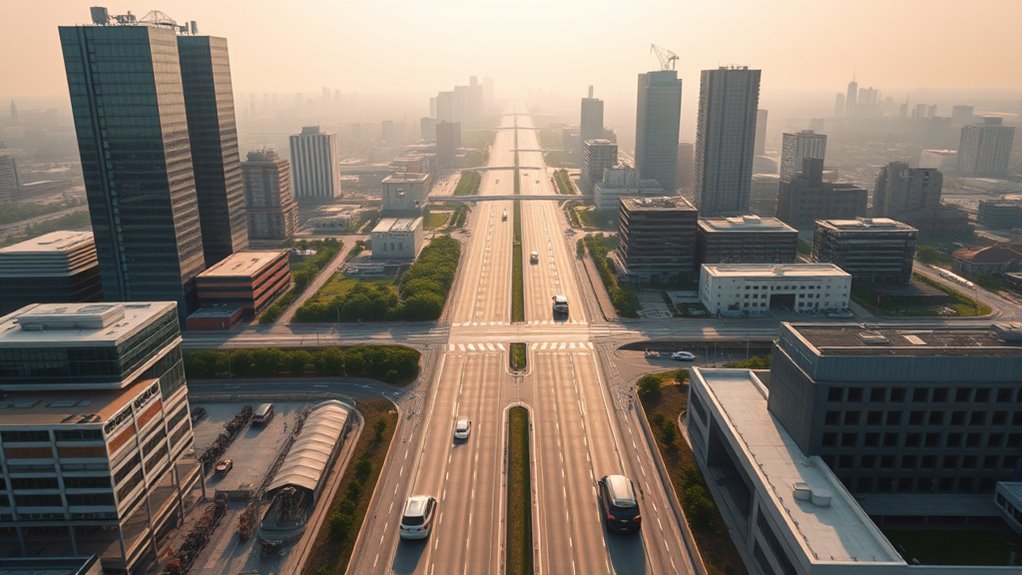
Have you ever wondered how cities transform after the decline of traditional manufacturing? As factories close and relocate, cities pivot from industrial hubs to centers of service, finance, and information. This shift isn’t just about jobs; it reshapes the entire urban landscape. Instead of producing goods, cities now focus on knowledge-based sectors like technology, finance, and information services, which fuel economic growth in new ways. Cities actively seek out opportunities in these fields, emphasizing sustainability, infrastructure upgrades, and vibrant community spaces. Financial institutions, in particular, tend to centralize in global cities, creating new economic orders and specialized labor markets that drive this post-labor transformation.
In this new landscape, urban labor markets become more complex. Large metropolitan areas foster innovation because they allow firms and workers to specialize, boosting productivity. Mobility within cities, supported by efficient transportation and flexible land markets, becomes essential. If people can easily move around, they can access better opportunities, which benefits the economy overall. However, fragmentation of labor markets can hinder efficiency, leading to pockets of inequality and reduced urban welfare. Physical proximity encourages knowledge spillovers, tech transfer, and innovation, making cities vibrant engines of progress. Additionally, informational networks help workers develop skills and find employment, fueling economic activity.
Despite these advances, post-labor cities face rising inequality and social divides. Wealth becomes concentrated in city centers, where highly educated, young, high-income earners flock to enjoy the amenities, entertainment, and retail options. Meanwhile, the growth of a professional class supports the financial and knowledge sectors, creating a stark contrast with working classes that sustain these industries. Gentrification and the rise of “urban chic” deepen socioeconomic divides and cause spatial segregation, leaving some neighborhoods affluent while others struggle. This uneven development highlights the uneven distribution of wealth and opportunities within cities.
At the same time, globalization integrates cities into a worldwide economic network. Urban areas are less tied to their national contexts and more connected to global markets. Competition among cities to attract capital and skilled labor intensifies, often leading to a “race to the bottom” in labor and environmental standards. Financial firms spread their operations across multiple cities, linking urban economies into a complex web. City governments adapt their roles, forging new relationships with national states to navigate this global landscape. These global cities become hubs where finance, infrastructure, and populations converge, creating interconnected urban ecosystems. Furthermore, the rise of digital connectivity enhances the capacity of cities to participate in this global network, facilitating real-time communication and data exchange.
Finally, consumption-driven growth takes center stage. Cities evolve into places of leisure and luxury, attracting affluent populations with amenities and entertainment options. This “great inversion” sees corporate activity, entertainment, and residents returning to urban cores, fueling urban revival. In this environment, cities are no longer just places of production but vibrant centers of consumption, innovation, and global connectivity.
Frequently Asked Questions
How Do Post-Labor Cities Attract New Industries?
You can attract new industries by transforming old industrial sites into vibrant cultural and innovation hubs. Focus on developing infrastructure that supports advanced manufacturing and tech startups. Invest in green spaces, sustainable practices, and modern transportation to appeal to eco-conscious businesses. Engage with community and government partners to offer incentives, foster collaboration, and create a dynamic environment that appeals to diverse industries seeking growth and sustainability.
What Role Does Technology Play in Post-Labor Economies?
You might think technology alone drives economic growth, but evidence shows it also reshapes industries and job markets. In post-labor economies, technology plays a vital role by boosting productivity, creating new roles, and fostering innovation. It helps cities diversify, develop smart infrastructure, and provide training programs. This way, technology isn’t just a tool; it’s a catalyst for economic resilience, enabling urban areas to adapt and thrive amid changing employment landscapes.
How Do Post-Labor Cities Address Income Inequality?
You can see that addressing income inequality in post-labor cities involves multiple strategies. Policies like investing in education and vocational training help bridge skill gaps, while urban planning promotes mixed-income housing to reduce disparities. Wage regulations and social safety nets support fair wages and protect vulnerable populations. Additionally, government stimulus and community programs foster economic inclusion, ensuring more equitable growth and opportunity across diverse neighborhoods.
What Policies Support Economic Diversification in These Cities?
You seek policies that promote economic diversification. You implement subsidies that lower barriers, invest in workforce training to build skills, and craft regulatory frameworks that attract new industries. You develop master plans that prioritize multiple sectors, offer tax incentives to stimulate growth, and support infrastructure projects that enable expansion. You also foster collaboration between government and private sectors, creating a resilient economy that adapts and thrives amid changing market conditions.
How Is Education Evolving in Post-Labor Urban Environments?
You’ll see education evolving with more flexible, skill-focused models like online courses, microschools, and project-based learning. Practical workforce training becomes key, with strong industry partnerships and scalable programs. Technology plays a huge role, especially AI, improving teaching and assessment. Funding shifts toward workforce development and non-degree programs, making education more accessible. These changes prepare you for evolving job markets, emphasizing real-world skills and lifelong learning in a changing urban landscape.
Conclusion
As you consider the future of post-labor cities, remember they’re like phoenixes rising from the ashes—transforming challenges into new opportunities. Embracing innovation and adaptability will be key to shaping resilient urban economies. Just as a city’s heartbeat persists beyond traditional industries, so too must your mindset stay flexible. By reimagining these spaces, you help craft vibrant communities where growth can flourish, even when old jobs fade away. The future belongs to those willing to evolve.
